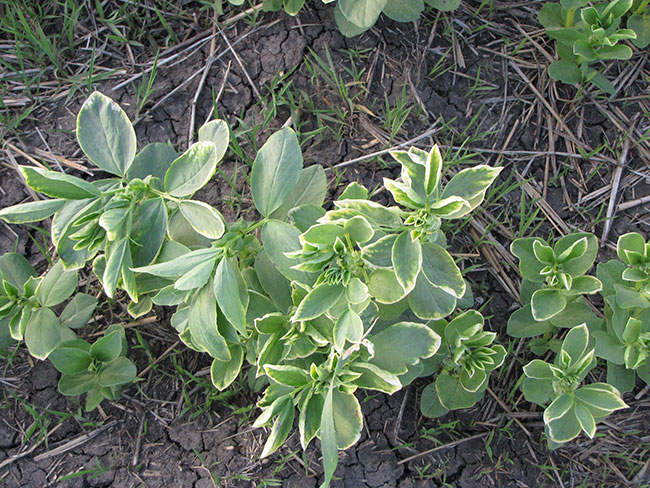
Features
Chemicals
Why is my crop damaged?
Registered herbicides interact with crops in predictable ways when applied correctly. What can cause things to go wrong?
February 26, 2024 By Alex Barnard
 Group 27 pyrasulfotole damage to faba bean. Photo courtesy of Eric Johnson.
Group 27 pyrasulfotole damage to faba bean. Photo courtesy of Eric Johnson. Peter Sikkema, professor of field crop weed management at the University of Guelph, Ridgetown Campus, has encountered many instances of difficult-to-explain crop injury during his career. At the Ontario Agriculture Conference in January, Sikkema presented on registered herbicide-caused crop injury, providing examples from his decades of experience consulting with farmers in southwestern Ontario. Several of the causes of herbicide injury he discussed are included below.
Extremes in weather
Too much moisture, not enough moisture, or too much rain, too quickly – the weather can play havoc with how herbicide interacts with a crop. Temperature fluctuations can, as well. Sikkema quoted the Steadfast label, which states “a rapid fluctuation in temperature (greater than 20 C difference within 24-36 hours) will stress the corn crop. For maximum crop safety, allow 24 hours for the corn to acclimatize before spraying.”
One concern for parts of the country that have experienced severe drought over the past few seasons is herbicide carryover, where there isn’t adequate moisture for the herbicide to break down so it lingers in the soil. If the herbicide and the next crop in that field aren’t compatible, it can lead to damage.
Soil characteristics
Unique or variable soil characteristics are another reason a farmer might see herbicide injury in their crop. This is because soil texture and organic matter levels affect herbicide uptake and injury potential. What makes this particularly challenging to avoid is that subtle changes in soil characteristics and elevation can have sizeable effects on how the herbicide is taken up by the plant.
Application errors
Application timing is also a potential factor affecting herbicide injury of a crop. Sikkema noted that 3 p.m. is the best time of day to spray if you want the greatest crop injury in general. But using products that are meant for fall application in the spring instead, or pre-emergence instead of post-emergence, will also increase the likelihood of damaging the crop.
Occasionally, the issue is simply human error. Sikkema related a story about a grower who was given the wrong herbicide when he went to pick it up because the products had similar names.
Another issue can be spray overlap. If multiple active ingredients are applied at a higher than label rate – for instance, spraying the excess remaining in the tank on a repeat pass – can overload the crop trying to take it up. This practice won’t always cause problems, as whether or not it damages the crop is dependent on several factors.
Adding too many active ingredients to the tank can lead to severe crop injury. Also, just because a product or tank mix is registered in your region doesn’t make it a good idea in all conditions nor completely unable to injure a crop.
Herbicide residues
Do you clean your tank after you’ve finished spraying? It may save time on busy days to refrain, but it could cost your crop. Tank and boom contamination can cause herbicide injury, as the residues remaining from a previous spray could be incompatible with the crop currently being sprayed.
Herbicide off-target movement – or drift – can be a major cause of herbicide injury, especially if it’s glyphosate drifting onto crops that aren’t able to tolerate glyphosate. It’s possible to see variations in a field if it’s been seeded with both glyphosate-tolerant and intolerant varieties. It’s not just a problem within a field, too – the products used can negatively impact neighbouring fields, as well.
Sikkema ended his presentation on a positive note: despite these injuries, crops are frequently able to recover – even if the injury is severe. So, before you consider the crop a loss, consult with an agronomist or herbicide professional to discuss your options.
Print this page